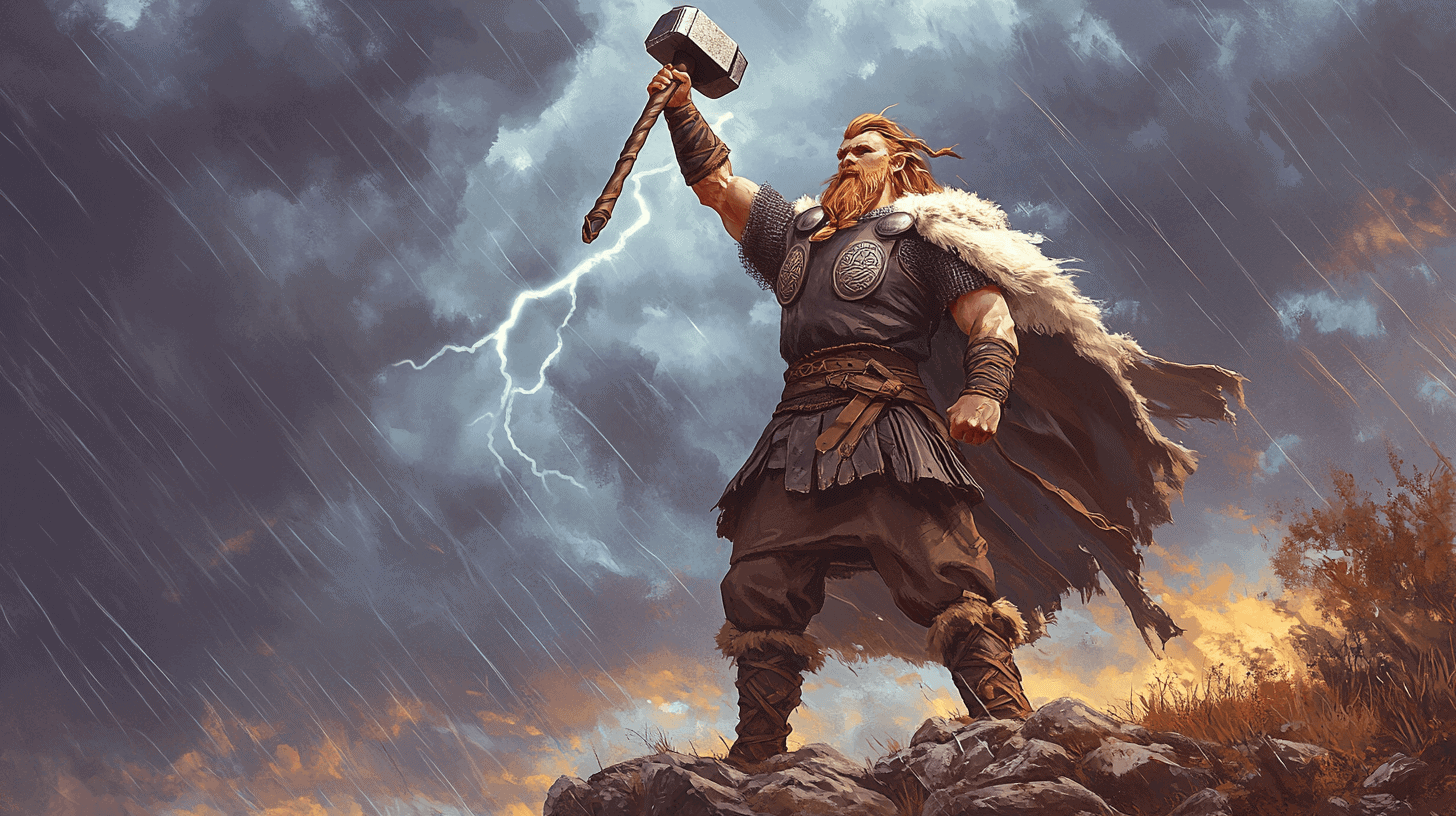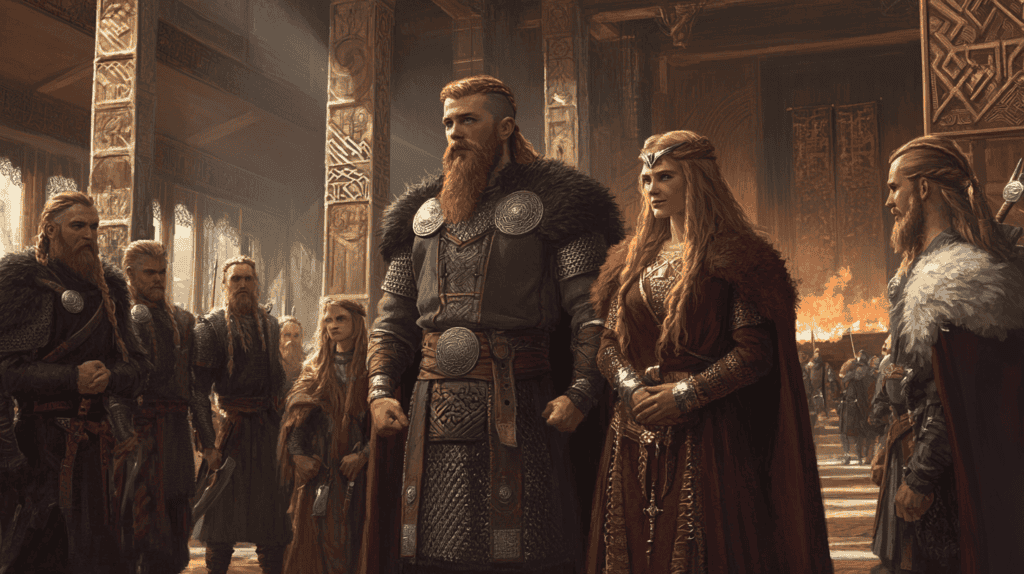
Thor, the mighty god of thunder in Norse mythology, stands as one of the most iconic and revered deities in the pantheon. As the offspring of Odin, the chief of the gods, and Jord (also known as Fjorgynn), the personification of Earth, Thor inherits both divine authority and a profound connection to the natural world. He is married to Sif, the goddess of fertility, and fathers several children including Modi, Magni, and Thrud. Thor also has a stepson, Ullr, who is Sif’s son from a previous marriage. This divine family structure reinforces Thor’s role as a protector of both gods and humans, bridging the realms of the celestial and the earthly.

Attributes and Symbols
Thor’s most famous attribute is Mjölnir, his mighty hammer. This legendary weapon serves multiple purposes:
- It controls weather, particularly thunder and lightning
- Acts as a formidable tool in battle
- Serves as a symbol of protection and blessing
Mjölnir is said to be the most powerful weapon in all the Nine Worlds, capable of crushing even mountains. When Thor throws the hammer, it magically returns to his hand, making it an invaluable asset in combat.
In addition to Mjölnir, Thor possesses other magical items that enhance his already formidable powers:
- Megingjord: A belt of strength that doubles his already impressive might
- Jarngreipr: Iron gloves that allow him to wield Mjölnir effectively
Thor’s appearance is distinctive and memorable. He is described as having red hair and a bushy beard, with fierce eyes that reflect his temperamental nature. This vivid portrayal adds to his charismatic and powerful image.
Thor’s mode of transportation is equally legendary – a chariot pulled by two magical goats, Tanngrisnir and Tanngnjóstr. These goats possess the remarkable ability to be slain and eaten, only to be resurrected the following day if their bones remain unbroken. This unique feature not only showcases Thor’s divine powers but also connects him to the cycles of nature and regeneration.

Role in Norse Mythology
Thor’s primary role in Norse mythology is that of a protector. He defends both the realm of the gods (Asgard) and the world of humans (Midgard) from various threats, particularly the jötnar (giants). His constant battles against these forces of chaos are often interpreted as the source of thunder and lightning in the mortal world.
As the god of thunder, Thor also holds dominion over the weather, making him a crucial deity for agricultural societies. His influence extends to fertility, crops, and the general prosperity of the land. This multifaceted nature made Thor especially popular among common people, who saw in him a divine champion of their everyday concerns.

Thor’s importance in Viking culture cannot be overstated. He was not only a god of thunder but also the patron of farmers and free people. Vikings often wore amulets in the shape of Thor’s hammer, Mjölnir, as symbols of protection and to invoke his blessings. These amulets have been found in archaeological sites across the Norse world, attesting to Thor’s widespread popularity and the deep reverence people held for him.
Famous Myths and Adventures
Thor’s exploits form a significant portion of Norse mythology. Some of his most renowned adventures include:
- The retrieval of Mjölnir: When the giant Thrym steals Thor’s hammer, the god must disguise himself as Freyja, the bride Thrym demands in exchange for the hammer. This tale, known as Thrymskvida, showcases not only Thor’s strength but also his willingness to go to great lengths to protect the realms.
- The fishing expedition: Thor attempts to catch and slay Jörmungandr, the Midgard Serpent, using an ox head as bait. This encounter foreshadows their final battle during Ragnarök, the twilight of the gods.
- The journey to Útgarða-Loki: Thor and his companions face a series of impossible challenges set by the giant king, unknowingly competing against personifications of natural phenomena. This story highlights Thor’s determination and the clever deceptions of his adversaries.

These stories not only entertain but also illustrate Thor’s character – his strength, determination, and occasional moments of cunning. They also serve to explain natural phenomena, linking Thor to the etiological aspects of mythology.
Thor’s Role in Ragnarök
Ragnarök, the prophesied end of the world in Norse mythology, features Thor prominently. In this final battle, Thor is destined to face his greatest enemy, the Midgard Serpent Jörmungandr. Their confrontation is foretold to be epic and ultimately fatal for both. Thor will succeed in slaying the monstrous serpent but will only take nine steps before succumbing to its venom.
This prophecy adds a layer of tragic heroism to Thor’s character. Despite knowing his fate, he continues to protect the realms and fight against the forces of chaos, embodying the Norse ideals of courage and duty in the face of inevitable doom.

Cultural Impact and Modern Interpretations
Thor’s influence extended far beyond religious worship in Viking society. His image was widely used in amulets and other protective symbols, with Thor’s hammer being particularly popular. Archaeological findings suggest that Thor was one of the most widely venerated gods across the Norse world.
The enduring popularity of Thor speaks to the timeless appeal of his character – a powerful yet relatable figure who embodies the struggle against chaos and the protection of the vulnerable. His myths continue to offer insights into Norse values, the human relationship with nature, and the eternal quest for security in an uncertain world.
Thor’s legacy also lives on in our modern languages. The English word “Thursday” (Thor’s Day) and the German “Donnerstag” (Donar’s Day, Donar being the earlier Germanic version of Thor) both pay homage to this mighty god.
In conclusion, Thor stands as a central figure in Norse mythology, embodying the ideals of strength, protection, and the awesome power of nature. From his origins as the son of Odin to his final battle at Ragnarök, Thor’s stories continue to inspire and captivate, bridging the ancient world of the Vikings with our modern imagination.




